|
Ancient Objects of Adornment
QUESTION:
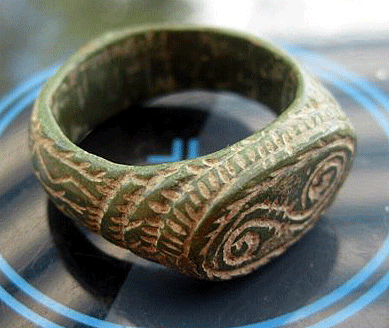 I’ve
loved jewelry since I was a kid. I used to play dress up and my
mom bought me some bling at yard sales. As an adult I began
looking at jewelry more seriously and now have a small but
distinctive collection. On a visit to the Metropolitan Museum of
Art in New York, I was amazed at some of the ancient jewelry on
display. What can you tell me about this early jewelry? How far
back was it used? I’ve
loved jewelry since I was a kid. I used to play dress up and my
mom bought me some bling at yard sales. As an adult I began
looking at jewelry more seriously and now have a small but
distinctive collection. On a visit to the Metropolitan Museum of
Art in New York, I was amazed at some of the ancient jewelry on
display. What can you tell me about this early jewelry? How far
back was it used?
Thanks,
Christine
____________________________________________________
ANSWER:
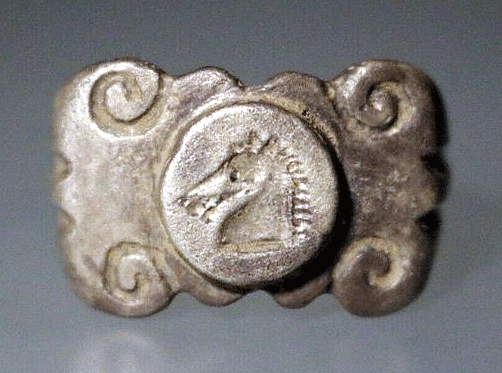 The
earliest traces of jewelry can be traced to the civilizations that grew
in around the Mediterranean Sea and in the area now called Iran around
3,000 to 400 BCE. These were usually simple stone amulets and seals.
Many of these amulets and seals carried spiritual meanings, stars, and
floral designs. The
earliest traces of jewelry can be traced to the civilizations that grew
in around the Mediterranean Sea and in the area now called Iran around
3,000 to 400 BCE. These were usually simple stone amulets and seals.
Many of these amulets and seals carried spiritual meanings, stars, and
floral designs.
The word jewelry itself is derived from the word jewel, which was
anglicized from the Old French "jouel", and beyond that, to the
Latin word "jocale", meaning plaything. Since ancient times,
jewelry has consisted of decorative items worn for personal adornment,
such as brooches, rings, necklaces, earrings, pendants, bracelets, and
cufflinks. Jewelry may be attached to the body or the clothes.
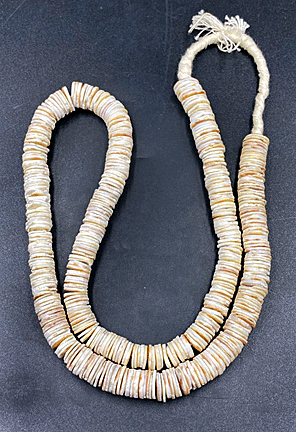 The
earliest jewelry discovered was from a cave in Monaco, a necklace made
of fish bones, 25,000 years ago. Ancient peoples wore jewelry made of
feathers, bones, shells, and colored pebbles. These colored pebbles were
gems and gems have been admired for their beauty and durability and made
into adornments. Diamonds weren’t popular until people learned how to
cut them to show their brilliance, which began in Europe sometime around
the 1300. Many types of jewelry items still made today began as
functional objects. Pins and brooches originated from the clasps that
held clothing together. People used rings and pendants as signs of
identification, rank, and authority, as well as for early seals. The
earliest jewelry discovered was from a cave in Monaco, a necklace made
of fish bones, 25,000 years ago. Ancient peoples wore jewelry made of
feathers, bones, shells, and colored pebbles. These colored pebbles were
gems and gems have been admired for their beauty and durability and made
into adornments. Diamonds weren’t popular until people learned how to
cut them to show their brilliance, which began in Europe sometime around
the 1300. Many types of jewelry items still made today began as
functional objects. Pins and brooches originated from the clasps that
held clothing together. People used rings and pendants as signs of
identification, rank, and authority, as well as for early seals.
The need to feel accepted, to belong, can be as important as the needs
we fulfill in caring for our bodies. A sense of identity and self-esteem
is not a frill, so belonging reflects a need, too. The first adornments
were derived from the hunt; teeth, claws, horns, and bones. Hunters
believed that wearing trophies would bring them good luck for the next
hunt. Remember, the village lived day to day by the virtue of a good
hunter and this person deserved respect and privileges. Of course, the
best hunter wanted to show they had courage and prowess. And in early
societies, people wore jewelry as amulets to protect them against bad
luck and illness.
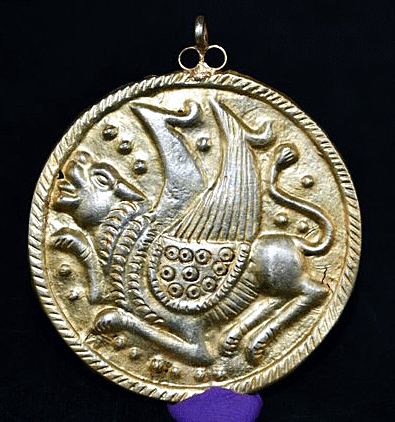 Ancient
people found luck and fortune because of gemstones and jewelry. They
made jewelry into symbols they believed would give them control over
fertility, wealth, and love. Some even wore jewelry for its magical
properties. Ancient
people found luck and fortune because of gemstones and jewelry. They
made jewelry into symbols they believed would give them control over
fertility, wealth, and love. Some even wore jewelry for its magical
properties.
People offered jewelry to the gods and often adorned statues of them
with it. The Royal Tombs in ancient Sumner, dating back to 3000 BCE
offered up a great jewelry collection. Archaeologists discovered mummies
encrusted with every imaginable type of jewelry, including headdresses,
necklaces, earrings, rings, crowns, and pins.
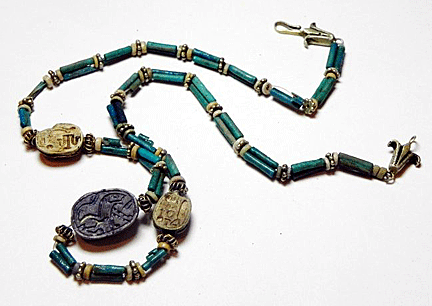 Then
there were the ancient Egyptians; who also wore amulets and talismans,
One of the most common motifs was the scarab, a carving of a small
beetle. Another common one was the ankh, the symbol of life. Many
ancient Egyptians wore multiple strands of beads in a variety of colors.
The Egyptians also created bracelets of multiple strands of colored
gemstones---amethyst, carnelian, green feldspar, and turquoise—embedded
in gold. Then
there were the ancient Egyptians; who also wore amulets and talismans,
One of the most common motifs was the scarab, a carving of a small
beetle. Another common one was the ankh, the symbol of life. Many
ancient Egyptians wore multiple strands of beads in a variety of colors.
The Egyptians also created bracelets of multiple strands of colored
gemstones---amethyst, carnelian, green feldspar, and turquoise—embedded
in gold.
The Egyptians also used symbols to show territorial pride—the vulture
represented Nekhbet, patron of the Upper Egypt and the cobra stood for
Lower Egypt. The royal jewelers used gold, silver, turquoise,
chalcedony, amethyst, and lapis lazuli The ancient Egyptians were also
famous for their faience, a glass-like tin glaze on clay, and inlays of
glass.
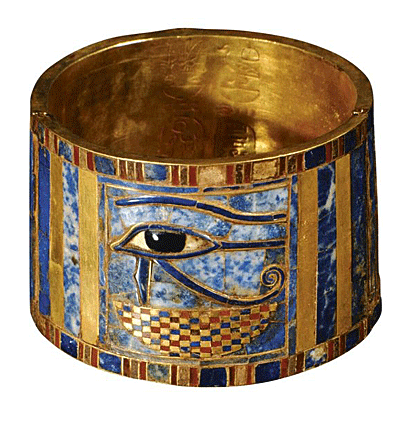 Color
played a significant role in ancient Egyptian culture. They believed
strongly that color reflected people’s personalities, and as a result,
color symbolism became an important part of jewelry design. The
Egyptians associated yellow and gold with the sun, and thus used them in
crowns and ornaments for the pharaoh and his priests. They placed a
green stone in the mouths of the pharaohs to restore speech in the other
world and believed the red AB or heart amulet preserves the soul. The
golden Udjat provided health and protection. Color
played a significant role in ancient Egyptian culture. They believed
strongly that color reflected people’s personalities, and as a result,
color symbolism became an important part of jewelry design. The
Egyptians associated yellow and gold with the sun, and thus used them in
crowns and ornaments for the pharaoh and his priests. They placed a
green stone in the mouths of the pharaohs to restore speech in the other
world and believed the red AB or heart amulet preserves the soul. The
golden Udjat provided health and protection.
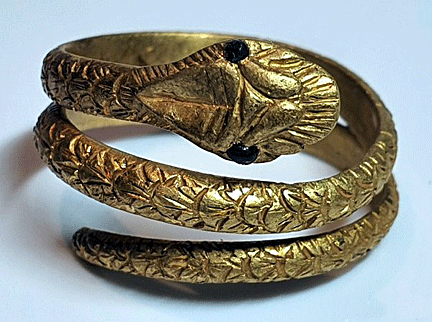 Ancient
Greek jewelry was rich and varied and reflected the prosperity of the
society. At first, they copied Eastern Motifs but then later developed
their own style following their beliefs in the gods and symbols. Greek
jewelry included crowns, earrings, bracelets, rings, hairpins,
necklaces, and brooches. Greek women sometimes wore necklaces with 75 or
more dangling miniature vases. Ancient
Greek jewelry was rich and varied and reflected the prosperity of the
society. At first, they copied Eastern Motifs but then later developed
their own style following their beliefs in the gods and symbols. Greek
jewelry included crowns, earrings, bracelets, rings, hairpins,
necklaces, and brooches. Greek women sometimes wore necklaces with 75 or
more dangling miniature vases.
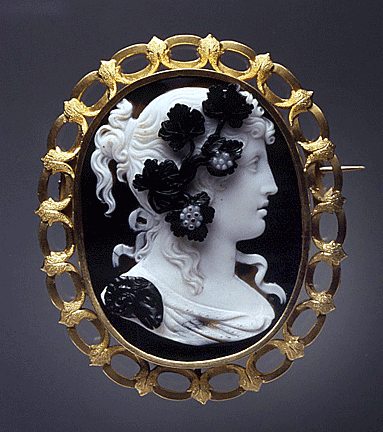 By
the Roman era, most gem stones used in jewelry today had been
discovered. Myth and magic was the rule of the day, and the Romans
treated gemstones with respect. Another form of jewelry preferred by the
Romans was the cameo, which they cherished it for its beauty. Bracelets
for the wrist and upper arms as well as necklaces became popular, as did
jewelry made from gold coins. By
the Roman era, most gem stones used in jewelry today had been
discovered. Myth and magic was the rule of the day, and the Romans
treated gemstones with respect. Another form of jewelry preferred by the
Romans was the cameo, which they cherished it for its beauty. Bracelets
for the wrist and upper arms as well as necklaces became popular, as did
jewelry made from gold coins.
In most ancient cultures, people cherished jewelry for its material
properties, its patterns, or its meaningful symbols.
<
Back to Readers Ask Archives
Next
Article > |
